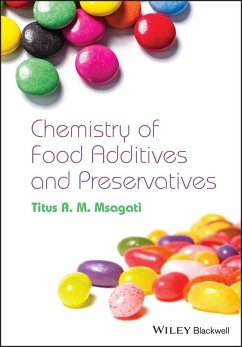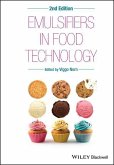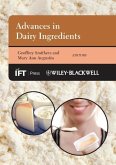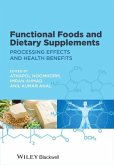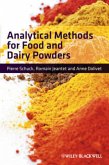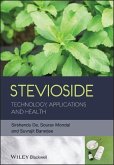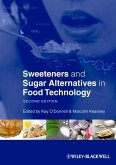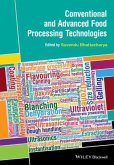Titus A. M. Msagati
Chemistry of Food Additives and Preservatives
Titus A. M. Msagati
Chemistry of Food Additives and Preservatives
- Gebundenes Buch
- Merkliste
- Auf die Merkliste
- Bewerten Bewerten
- Teilen
- Produkt teilen
- Produkterinnerung
- Produkterinnerung
The Chemistry of Food Additives and Preservatives is an up-to-date reference guide on the range of different types of additives (both natural and synthetic) used in the food industry today. It looks at the processes involved in inputting additives and preservatives to foods, and the mechanisms and methods used. The book contains full details about the chemistry of each major class of food additive, showing the reader not just what kind of additives are used and what their functions are, but also how they work and how they can have multiple functionalities. In addition, this book covers…mehr
Andere Kunden interessierten sich auch für
![Emulsifiers in Food Technology Emulsifiers in Food Technology]() Emulsifiers in Food Technology245,99 €
Emulsifiers in Food Technology245,99 €![Advances in Dairy Ingredients Advances in Dairy Ingredients]() Advances in Dairy Ingredients270,99 €
Advances in Dairy Ingredients270,99 €![Functional Foods and Dietary Supplements Functional Foods and Dietary Supplements]() Functional Foods and Dietary Supplements250,99 €
Functional Foods and Dietary Supplements250,99 €![Analytical Methods for Food and Dairy Powders Analytical Methods for Food and Dairy Powders]() Pierre SchuckAnalytical Methods for Food and Dairy Powders233,99 €
Pierre SchuckAnalytical Methods for Food and Dairy Powders233,99 €![Stevioside Stevioside]() Sirshendu DeStevioside217,99 €
Sirshendu DeStevioside217,99 €![Sweeteners and Sugar Alternatives in Food Technology Sweeteners and Sugar Alternatives in Food Technology]() Sweeteners and Sugar Alternatives in Food Technology270,99 €
Sweeteners and Sugar Alternatives in Food Technology270,99 €![Conventional and Advanced Food Processing Technologies Conventional and Advanced Food Processing Technologies]() Conventional and Advanced Food Processing Technologies314,99 €
Conventional and Advanced Food Processing Technologies314,99 €-
-
-
The Chemistry of Food Additives and Preservatives is an up-to-date reference guide on the range of different types of additives (both natural and synthetic) used in the food industry today. It looks at the processes involved in inputting additives and preservatives to foods, and the mechanisms and methods used. The book contains full details about the chemistry of each major class of food additive, showing the reader not just what kind of additives are used and what their functions are, but also how they work and how they can have multiple functionalities. In addition, this book covers numerous new additives currently being introduced, and an explanation of how the quality of these is ascertained and how consumer safety is ensured.
Hinweis: Dieser Artikel kann nur an eine deutsche Lieferadresse ausgeliefert werden.
Hinweis: Dieser Artikel kann nur an eine deutsche Lieferadresse ausgeliefert werden.
Produktdetails
- Produktdetails
- Verlag: Wiley & Sons
- 1. Auflage
- Seitenzahl: 336
- Erscheinungstermin: 17. Dezember 2012
- Englisch
- Abmessung: 246mm x 175mm x 20mm
- Gewicht: 771g
- ISBN-13: 9781118274149
- ISBN-10: 1118274148
- Artikelnr.: 36519728
- Herstellerkennzeichnung
- Libri GmbH
- Europaallee 1
- 36244 Bad Hersfeld
- gpsr@libri.de
- Verlag: Wiley & Sons
- 1. Auflage
- Seitenzahl: 336
- Erscheinungstermin: 17. Dezember 2012
- Englisch
- Abmessung: 246mm x 175mm x 20mm
- Gewicht: 771g
- ISBN-13: 9781118274149
- ISBN-10: 1118274148
- Artikelnr.: 36519728
- Herstellerkennzeichnung
- Libri GmbH
- Europaallee 1
- 36244 Bad Hersfeld
- gpsr@libri.de
About the Author Dr Titus A. M. Msagati is a Senior Lecturer in the Department of Applied Chemistry at the University of Johannesburg, South Africa.
Preface ix
Introduction x
List of Abbreviations xiii
1 Antioxidants and Radical Scavengers 1
1.1 Chemistry of free radicals and antioxidants 1
1.2 Types of antioxidants 4
1.3 Efficacy of different antioxidants 7
1.4 Action mechanisms of antioxidants 9
1.5 Structure-activity relationship of antioxidants 11
1.6 Factors affecting antioxidant activity 14
1.7 Quality assessment of dietary antioxidants 15
1.8 How safe are food antioxidants? 23
1.9 Summary 25
References 25
Further reading 31
2 Emulsifiers 33
2.1 Mechanisms of food emulsifiers 33
2.2 The role of emulsifiers in foods 35
2.3 Classification of emulsifiers 37
2.4 Types of food emulsifiers 38
2.5 Quality and analysis of food emulsifiers 58
2.6 Foods containing emulsifiers 60
References 62
Further reading 64
3 Stabilisers, Gums, Thickeners and Gelling Agents as Food Additives 67
3.1 Introduction to stabilisers, thickeners and gelling agents 67
3.2 Polysaccharides 68
3.3 Protein-based food stabilisers 77
3.4 Quality control of food stabilisers and thickeners 78
3.5 Analytical methods 78
References 80
Further reading 82
4 Sweeteners 83
4.1 Introduction to sweeteners 83
4.2 Properties of sweeteners 84
4.3 Intense sweeteners in foods 86
4.4 Bulk food sweeteners 92
4.5 Quality assurance and quality control 95
4.6 Analytical methods 98
References 98
Further reading 100
5 Fragrances, Flavouring Agents and Enhancers 102
5.1 Introduction to flavours and flavouring agents 102
5.2 Classification of food flavourings 103
5.3 Chemistry of food flavourings 105
5.4 Quality control of flavour compounds 119
5.5 Analytical methods for the analysis of food flavourings 120
References 121
Further reading 124
6 Food Acids and Acidity Regulators 125
6.1 What are food acids and acid regulators? 125
6.2 Types of food acids 126
6.3 Uses of food acids 128
References 129
Further reading 130
7 Food Colour and Colour Retention Agents 131
7.1 Why add colourants to foods? 131
7.2 Classification of food colourants 131
7.3 Overview of colourants 133
7.4 Chemistry of food colourants 143
7.5 Extraction from natural sources 143
7.6 Quality assurance of food colourants 144
7.7 Analytical methods 145
References 145
8 Flour Treatment/Improving Agents 148
8.1 What are flour treatment/improving agents? 148
8.2 Flour maturing agents 148
8.3 Flour bleaching agents 151
8.4 Flour processing agents 154
References 154
9 Anticaking Agents 155
9.1 The caking phenomena 155
9.2 Mechanisms of caking 156
9.3 Classification of anticaking agents 159
9.4 Anticaking agents in use 159
References 160
Further reading 161
10 Humectants 162
10.1 Humectants and moisture control 162
10.2 Classification of humectants 162
References 166
11 Antifoaming Agents 167
11.1 Sources of foam in food processing 167
11.2 Properties of antifoaming agents 168
11.3 Mechanisms of antifoaming and foam destabilisation 168
11.4 Synthetic defoamers 168
11.5 Natural defoamers 170
References 171
12 Minerals and Mineral Salts 172
12.1 The importance of minerals and mineral salts 172
12.2 Inorganic mineral salts 173
12.3 Organic mineral salts 175
References 176
13 Dietary Supplements 177
13.1 Introduction to dietary supplements 177
13.2 Classification of vitamins 178
13.3 Vitamin A (retinols) 179
13.4 Vitamin D (calciferol) 189
13.5 Vitamin E 194
13.6 Vitamin K 196
13.7 Vitamin B 199
13.8 Vitamin C (L-ascorbic acid) 210
13.9 Conclusions 212
References 213
14 Glazing Agents 218
14.1 Introduction to glazing agents 218
14.2 Mineral hydrocarbon glazes 218
14.3 Chemistry of MHCs 220
14.4 Conclusion 222
References 223
15 Preservatives 224
15.1 Preservatives: Past, present and future 224
15.2 Natural food preservatives 226
15.3 Traditional food preservation methods 231
15.4 Artificial preservative agents 232
15.5 Modern food preservation techniques 235
15.6 Safety concerns of food preservatives 237
15.7 Analytical methods for the determination of preservative residues 238
15.8 Conclusions 238
References 238
Further reading 243
16 Nutraceuticals and Functional Foods 244
16.1 What are nutraceuticals? 244
16.2 Classification of nutraceuticals 245
16.3 Mechanisms of action 246
16.4 Conclusion 253
References 254
Further reading 257
17 Nutritional Genomics: Nutrigenetics and Nutrigenomics 258
17.1 Nutrition and gene expression 258
17.2 Nutrigenetic areas of application 260
17.3 Analytical methods for nutrigenetical food functions 268
17.4 Conclusion 270
References 270
18 Probiotic Foods and Dietary Supplements 274
18.1 Microbial gut flora activity 274
18.2 Probiotics and nutrition 275
18.3 Probiotics and health 275
18.4 Safety and stability of probiotics 277
18.5 Suitable dietary carriers for probiotics 278
18.6 Assessment of probiotics in foodstuffs and supplements 279
18.7 Conclusions 280
References 281
19 Prebiotics 285
19.1 Prebiotics and health 285
19.2 Factors that influence the activity and effectiveness of prebiotics
286
19.3 Types of oligosaccharides 286
19.4 Quality assessment of prebiotics 289
19.5 Conclusions 290
References 290
20 Synbiotics 291
20.1 Synbiotic foods and health 291
20.2 Health benefits of synbiotics 292
20.3 Mechanism of action of synbiotics 293
20.4 The future of synbotic foods 294
References 294
21 Microencapsulation and Bioencapsulation 295
21.1 Introduction to microencapsulation and bioencapsulation 295
21.2 Commonly used food-grade microcapsules 297
21.3 Methods of food microencapsulation 303
21.4 Microencapsulation for food colourants 307
21.5 Bioencapsulation for probiotics 309
21.6 Conclusions 310
References 310
General Conclusions 314
Index 315
Introduction x
List of Abbreviations xiii
1 Antioxidants and Radical Scavengers 1
1.1 Chemistry of free radicals and antioxidants 1
1.2 Types of antioxidants 4
1.3 Efficacy of different antioxidants 7
1.4 Action mechanisms of antioxidants 9
1.5 Structure-activity relationship of antioxidants 11
1.6 Factors affecting antioxidant activity 14
1.7 Quality assessment of dietary antioxidants 15
1.8 How safe are food antioxidants? 23
1.9 Summary 25
References 25
Further reading 31
2 Emulsifiers 33
2.1 Mechanisms of food emulsifiers 33
2.2 The role of emulsifiers in foods 35
2.3 Classification of emulsifiers 37
2.4 Types of food emulsifiers 38
2.5 Quality and analysis of food emulsifiers 58
2.6 Foods containing emulsifiers 60
References 62
Further reading 64
3 Stabilisers, Gums, Thickeners and Gelling Agents as Food Additives 67
3.1 Introduction to stabilisers, thickeners and gelling agents 67
3.2 Polysaccharides 68
3.3 Protein-based food stabilisers 77
3.4 Quality control of food stabilisers and thickeners 78
3.5 Analytical methods 78
References 80
Further reading 82
4 Sweeteners 83
4.1 Introduction to sweeteners 83
4.2 Properties of sweeteners 84
4.3 Intense sweeteners in foods 86
4.4 Bulk food sweeteners 92
4.5 Quality assurance and quality control 95
4.6 Analytical methods 98
References 98
Further reading 100
5 Fragrances, Flavouring Agents and Enhancers 102
5.1 Introduction to flavours and flavouring agents 102
5.2 Classification of food flavourings 103
5.3 Chemistry of food flavourings 105
5.4 Quality control of flavour compounds 119
5.5 Analytical methods for the analysis of food flavourings 120
References 121
Further reading 124
6 Food Acids and Acidity Regulators 125
6.1 What are food acids and acid regulators? 125
6.2 Types of food acids 126
6.3 Uses of food acids 128
References 129
Further reading 130
7 Food Colour and Colour Retention Agents 131
7.1 Why add colourants to foods? 131
7.2 Classification of food colourants 131
7.3 Overview of colourants 133
7.4 Chemistry of food colourants 143
7.5 Extraction from natural sources 143
7.6 Quality assurance of food colourants 144
7.7 Analytical methods 145
References 145
8 Flour Treatment/Improving Agents 148
8.1 What are flour treatment/improving agents? 148
8.2 Flour maturing agents 148
8.3 Flour bleaching agents 151
8.4 Flour processing agents 154
References 154
9 Anticaking Agents 155
9.1 The caking phenomena 155
9.2 Mechanisms of caking 156
9.3 Classification of anticaking agents 159
9.4 Anticaking agents in use 159
References 160
Further reading 161
10 Humectants 162
10.1 Humectants and moisture control 162
10.2 Classification of humectants 162
References 166
11 Antifoaming Agents 167
11.1 Sources of foam in food processing 167
11.2 Properties of antifoaming agents 168
11.3 Mechanisms of antifoaming and foam destabilisation 168
11.4 Synthetic defoamers 168
11.5 Natural defoamers 170
References 171
12 Minerals and Mineral Salts 172
12.1 The importance of minerals and mineral salts 172
12.2 Inorganic mineral salts 173
12.3 Organic mineral salts 175
References 176
13 Dietary Supplements 177
13.1 Introduction to dietary supplements 177
13.2 Classification of vitamins 178
13.3 Vitamin A (retinols) 179
13.4 Vitamin D (calciferol) 189
13.5 Vitamin E 194
13.6 Vitamin K 196
13.7 Vitamin B 199
13.8 Vitamin C (L-ascorbic acid) 210
13.9 Conclusions 212
References 213
14 Glazing Agents 218
14.1 Introduction to glazing agents 218
14.2 Mineral hydrocarbon glazes 218
14.3 Chemistry of MHCs 220
14.4 Conclusion 222
References 223
15 Preservatives 224
15.1 Preservatives: Past, present and future 224
15.2 Natural food preservatives 226
15.3 Traditional food preservation methods 231
15.4 Artificial preservative agents 232
15.5 Modern food preservation techniques 235
15.6 Safety concerns of food preservatives 237
15.7 Analytical methods for the determination of preservative residues 238
15.8 Conclusions 238
References 238
Further reading 243
16 Nutraceuticals and Functional Foods 244
16.1 What are nutraceuticals? 244
16.2 Classification of nutraceuticals 245
16.3 Mechanisms of action 246
16.4 Conclusion 253
References 254
Further reading 257
17 Nutritional Genomics: Nutrigenetics and Nutrigenomics 258
17.1 Nutrition and gene expression 258
17.2 Nutrigenetic areas of application 260
17.3 Analytical methods for nutrigenetical food functions 268
17.4 Conclusion 270
References 270
18 Probiotic Foods and Dietary Supplements 274
18.1 Microbial gut flora activity 274
18.2 Probiotics and nutrition 275
18.3 Probiotics and health 275
18.4 Safety and stability of probiotics 277
18.5 Suitable dietary carriers for probiotics 278
18.6 Assessment of probiotics in foodstuffs and supplements 279
18.7 Conclusions 280
References 281
19 Prebiotics 285
19.1 Prebiotics and health 285
19.2 Factors that influence the activity and effectiveness of prebiotics
286
19.3 Types of oligosaccharides 286
19.4 Quality assessment of prebiotics 289
19.5 Conclusions 290
References 290
20 Synbiotics 291
20.1 Synbiotic foods and health 291
20.2 Health benefits of synbiotics 292
20.3 Mechanism of action of synbiotics 293
20.4 The future of synbotic foods 294
References 294
21 Microencapsulation and Bioencapsulation 295
21.1 Introduction to microencapsulation and bioencapsulation 295
21.2 Commonly used food-grade microcapsules 297
21.3 Methods of food microencapsulation 303
21.4 Microencapsulation for food colourants 307
21.5 Bioencapsulation for probiotics 309
21.6 Conclusions 310
References 310
General Conclusions 314
Index 315
Preface ix
Introduction x
List of Abbreviations xiii
1 Antioxidants and Radical Scavengers 1
1.1 Chemistry of free radicals and antioxidants 1
1.2 Types of antioxidants 4
1.3 Efficacy of different antioxidants 7
1.4 Action mechanisms of antioxidants 9
1.5 Structure-activity relationship of antioxidants 11
1.6 Factors affecting antioxidant activity 14
1.7 Quality assessment of dietary antioxidants 15
1.8 How safe are food antioxidants? 23
1.9 Summary 25
References 25
Further reading 31
2 Emulsifiers 33
2.1 Mechanisms of food emulsifiers 33
2.2 The role of emulsifiers in foods 35
2.3 Classification of emulsifiers 37
2.4 Types of food emulsifiers 38
2.5 Quality and analysis of food emulsifiers 58
2.6 Foods containing emulsifiers 60
References 62
Further reading 64
3 Stabilisers, Gums, Thickeners and Gelling Agents as Food Additives 67
3.1 Introduction to stabilisers, thickeners and gelling agents 67
3.2 Polysaccharides 68
3.3 Protein-based food stabilisers 77
3.4 Quality control of food stabilisers and thickeners 78
3.5 Analytical methods 78
References 80
Further reading 82
4 Sweeteners 83
4.1 Introduction to sweeteners 83
4.2 Properties of sweeteners 84
4.3 Intense sweeteners in foods 86
4.4 Bulk food sweeteners 92
4.5 Quality assurance and quality control 95
4.6 Analytical methods 98
References 98
Further reading 100
5 Fragrances, Flavouring Agents and Enhancers 102
5.1 Introduction to flavours and flavouring agents 102
5.2 Classification of food flavourings 103
5.3 Chemistry of food flavourings 105
5.4 Quality control of flavour compounds 119
5.5 Analytical methods for the analysis of food flavourings 120
References 121
Further reading 124
6 Food Acids and Acidity Regulators 125
6.1 What are food acids and acid regulators? 125
6.2 Types of food acids 126
6.3 Uses of food acids 128
References 129
Further reading 130
7 Food Colour and Colour Retention Agents 131
7.1 Why add colourants to foods? 131
7.2 Classification of food colourants 131
7.3 Overview of colourants 133
7.4 Chemistry of food colourants 143
7.5 Extraction from natural sources 143
7.6 Quality assurance of food colourants 144
7.7 Analytical methods 145
References 145
8 Flour Treatment/Improving Agents 148
8.1 What are flour treatment/improving agents? 148
8.2 Flour maturing agents 148
8.3 Flour bleaching agents 151
8.4 Flour processing agents 154
References 154
9 Anticaking Agents 155
9.1 The caking phenomena 155
9.2 Mechanisms of caking 156
9.3 Classification of anticaking agents 159
9.4 Anticaking agents in use 159
References 160
Further reading 161
10 Humectants 162
10.1 Humectants and moisture control 162
10.2 Classification of humectants 162
References 166
11 Antifoaming Agents 167
11.1 Sources of foam in food processing 167
11.2 Properties of antifoaming agents 168
11.3 Mechanisms of antifoaming and foam destabilisation 168
11.4 Synthetic defoamers 168
11.5 Natural defoamers 170
References 171
12 Minerals and Mineral Salts 172
12.1 The importance of minerals and mineral salts 172
12.2 Inorganic mineral salts 173
12.3 Organic mineral salts 175
References 176
13 Dietary Supplements 177
13.1 Introduction to dietary supplements 177
13.2 Classification of vitamins 178
13.3 Vitamin A (retinols) 179
13.4 Vitamin D (calciferol) 189
13.5 Vitamin E 194
13.6 Vitamin K 196
13.7 Vitamin B 199
13.8 Vitamin C (L-ascorbic acid) 210
13.9 Conclusions 212
References 213
14 Glazing Agents 218
14.1 Introduction to glazing agents 218
14.2 Mineral hydrocarbon glazes 218
14.3 Chemistry of MHCs 220
14.4 Conclusion 222
References 223
15 Preservatives 224
15.1 Preservatives: Past, present and future 224
15.2 Natural food preservatives 226
15.3 Traditional food preservation methods 231
15.4 Artificial preservative agents 232
15.5 Modern food preservation techniques 235
15.6 Safety concerns of food preservatives 237
15.7 Analytical methods for the determination of preservative residues 238
15.8 Conclusions 238
References 238
Further reading 243
16 Nutraceuticals and Functional Foods 244
16.1 What are nutraceuticals? 244
16.2 Classification of nutraceuticals 245
16.3 Mechanisms of action 246
16.4 Conclusion 253
References 254
Further reading 257
17 Nutritional Genomics: Nutrigenetics and Nutrigenomics 258
17.1 Nutrition and gene expression 258
17.2 Nutrigenetic areas of application 260
17.3 Analytical methods for nutrigenetical food functions 268
17.4 Conclusion 270
References 270
18 Probiotic Foods and Dietary Supplements 274
18.1 Microbial gut flora activity 274
18.2 Probiotics and nutrition 275
18.3 Probiotics and health 275
18.4 Safety and stability of probiotics 277
18.5 Suitable dietary carriers for probiotics 278
18.6 Assessment of probiotics in foodstuffs and supplements 279
18.7 Conclusions 280
References 281
19 Prebiotics 285
19.1 Prebiotics and health 285
19.2 Factors that influence the activity and effectiveness of prebiotics
286
19.3 Types of oligosaccharides 286
19.4 Quality assessment of prebiotics 289
19.5 Conclusions 290
References 290
20 Synbiotics 291
20.1 Synbiotic foods and health 291
20.2 Health benefits of synbiotics 292
20.3 Mechanism of action of synbiotics 293
20.4 The future of synbotic foods 294
References 294
21 Microencapsulation and Bioencapsulation 295
21.1 Introduction to microencapsulation and bioencapsulation 295
21.2 Commonly used food-grade microcapsules 297
21.3 Methods of food microencapsulation 303
21.4 Microencapsulation for food colourants 307
21.5 Bioencapsulation for probiotics 309
21.6 Conclusions 310
References 310
General Conclusions 314
Index 315
Introduction x
List of Abbreviations xiii
1 Antioxidants and Radical Scavengers 1
1.1 Chemistry of free radicals and antioxidants 1
1.2 Types of antioxidants 4
1.3 Efficacy of different antioxidants 7
1.4 Action mechanisms of antioxidants 9
1.5 Structure-activity relationship of antioxidants 11
1.6 Factors affecting antioxidant activity 14
1.7 Quality assessment of dietary antioxidants 15
1.8 How safe are food antioxidants? 23
1.9 Summary 25
References 25
Further reading 31
2 Emulsifiers 33
2.1 Mechanisms of food emulsifiers 33
2.2 The role of emulsifiers in foods 35
2.3 Classification of emulsifiers 37
2.4 Types of food emulsifiers 38
2.5 Quality and analysis of food emulsifiers 58
2.6 Foods containing emulsifiers 60
References 62
Further reading 64
3 Stabilisers, Gums, Thickeners and Gelling Agents as Food Additives 67
3.1 Introduction to stabilisers, thickeners and gelling agents 67
3.2 Polysaccharides 68
3.3 Protein-based food stabilisers 77
3.4 Quality control of food stabilisers and thickeners 78
3.5 Analytical methods 78
References 80
Further reading 82
4 Sweeteners 83
4.1 Introduction to sweeteners 83
4.2 Properties of sweeteners 84
4.3 Intense sweeteners in foods 86
4.4 Bulk food sweeteners 92
4.5 Quality assurance and quality control 95
4.6 Analytical methods 98
References 98
Further reading 100
5 Fragrances, Flavouring Agents and Enhancers 102
5.1 Introduction to flavours and flavouring agents 102
5.2 Classification of food flavourings 103
5.3 Chemistry of food flavourings 105
5.4 Quality control of flavour compounds 119
5.5 Analytical methods for the analysis of food flavourings 120
References 121
Further reading 124
6 Food Acids and Acidity Regulators 125
6.1 What are food acids and acid regulators? 125
6.2 Types of food acids 126
6.3 Uses of food acids 128
References 129
Further reading 130
7 Food Colour and Colour Retention Agents 131
7.1 Why add colourants to foods? 131
7.2 Classification of food colourants 131
7.3 Overview of colourants 133
7.4 Chemistry of food colourants 143
7.5 Extraction from natural sources 143
7.6 Quality assurance of food colourants 144
7.7 Analytical methods 145
References 145
8 Flour Treatment/Improving Agents 148
8.1 What are flour treatment/improving agents? 148
8.2 Flour maturing agents 148
8.3 Flour bleaching agents 151
8.4 Flour processing agents 154
References 154
9 Anticaking Agents 155
9.1 The caking phenomena 155
9.2 Mechanisms of caking 156
9.3 Classification of anticaking agents 159
9.4 Anticaking agents in use 159
References 160
Further reading 161
10 Humectants 162
10.1 Humectants and moisture control 162
10.2 Classification of humectants 162
References 166
11 Antifoaming Agents 167
11.1 Sources of foam in food processing 167
11.2 Properties of antifoaming agents 168
11.3 Mechanisms of antifoaming and foam destabilisation 168
11.4 Synthetic defoamers 168
11.5 Natural defoamers 170
References 171
12 Minerals and Mineral Salts 172
12.1 The importance of minerals and mineral salts 172
12.2 Inorganic mineral salts 173
12.3 Organic mineral salts 175
References 176
13 Dietary Supplements 177
13.1 Introduction to dietary supplements 177
13.2 Classification of vitamins 178
13.3 Vitamin A (retinols) 179
13.4 Vitamin D (calciferol) 189
13.5 Vitamin E 194
13.6 Vitamin K 196
13.7 Vitamin B 199
13.8 Vitamin C (L-ascorbic acid) 210
13.9 Conclusions 212
References 213
14 Glazing Agents 218
14.1 Introduction to glazing agents 218
14.2 Mineral hydrocarbon glazes 218
14.3 Chemistry of MHCs 220
14.4 Conclusion 222
References 223
15 Preservatives 224
15.1 Preservatives: Past, present and future 224
15.2 Natural food preservatives 226
15.3 Traditional food preservation methods 231
15.4 Artificial preservative agents 232
15.5 Modern food preservation techniques 235
15.6 Safety concerns of food preservatives 237
15.7 Analytical methods for the determination of preservative residues 238
15.8 Conclusions 238
References 238
Further reading 243
16 Nutraceuticals and Functional Foods 244
16.1 What are nutraceuticals? 244
16.2 Classification of nutraceuticals 245
16.3 Mechanisms of action 246
16.4 Conclusion 253
References 254
Further reading 257
17 Nutritional Genomics: Nutrigenetics and Nutrigenomics 258
17.1 Nutrition and gene expression 258
17.2 Nutrigenetic areas of application 260
17.3 Analytical methods for nutrigenetical food functions 268
17.4 Conclusion 270
References 270
18 Probiotic Foods and Dietary Supplements 274
18.1 Microbial gut flora activity 274
18.2 Probiotics and nutrition 275
18.3 Probiotics and health 275
18.4 Safety and stability of probiotics 277
18.5 Suitable dietary carriers for probiotics 278
18.6 Assessment of probiotics in foodstuffs and supplements 279
18.7 Conclusions 280
References 281
19 Prebiotics 285
19.1 Prebiotics and health 285
19.2 Factors that influence the activity and effectiveness of prebiotics
286
19.3 Types of oligosaccharides 286
19.4 Quality assessment of prebiotics 289
19.5 Conclusions 290
References 290
20 Synbiotics 291
20.1 Synbiotic foods and health 291
20.2 Health benefits of synbiotics 292
20.3 Mechanism of action of synbiotics 293
20.4 The future of synbotic foods 294
References 294
21 Microencapsulation and Bioencapsulation 295
21.1 Introduction to microencapsulation and bioencapsulation 295
21.2 Commonly used food-grade microcapsules 297
21.3 Methods of food microencapsulation 303
21.4 Microencapsulation for food colourants 307
21.5 Bioencapsulation for probiotics 309
21.6 Conclusions 310
References 310
General Conclusions 314
Index 315

